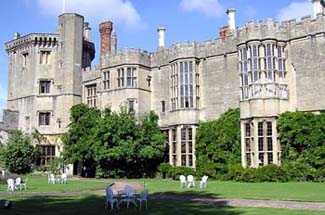
Photos courtesy of Thornbury Castle
Thornbury, Nr. Bristol
South Gloucester BS35 1HH
Tel: ++44 (0)1454 281182
Fax: ++44 (0)1454 416188
Hotel website
Reserve with Booking.com
25 rooms, including 4 suites
2 bedrooms in gatehouse
Double rooms: £85–675
Rates include breakfast
2-night minimum stays on
weekends
Special offers available
Open: all year
Thornbury is about a 1/2- hour drive north of Bristol. Exit from either the M4 or M5, depending on which direction you’re coming from, onto A38. Watch for side road B4061. The castle gate is next to St Mary’s parish church.
On site: clay pigeon shooting;
falconry
Nearby: golf; horseback
riding; fishing; excursions
to the Cotswolds, Bristol,
Bath, and South Wales.
Yes. Receptions. Inquire hotel for details.
Anyone who thinks a castle is a gloomy, damp, and cheerless place to spend the night is sure to be impressed by the warmth and coziness of Thornbury Castle—the last major fortified manor house built in England.
Upon entering the castle, look closely over the gateway and you will find an inscription by its former owner, the duke of Buckingham. Badges of his coat of arms are also found over the gatehouse, windows, and fireplaces.
A double brick chimney on the south side is unique in England. The oriel windows on the same side are fine examples of tracery (one has 720 panes of curved glass). The library has a fine view, over hedges and flowers, to the spire of the village church.
No expense has been spared to transform the individually furnished guest rooms into ultimate retreats. Four-poster beds, beautifully carved in a 16th-century style, were especially commissioned for the rooms. High ceilings and tall mullioned windows looking out over the gardens remind you of the castle’s origins.
The Tower Room is exceptional. Its walls are covered in silk, deep rose-colored brocades frame the canopy bed, and a sitting area and fireplace provide coziness, not to mention its bathroom has gold-plated fittings.
The paneled walls, heraldic shield, and open fireplaces in the baronial dining room create a cozy atmosphere for sampling the first-rate cuisine.
![]() Thornbury produces its own Riesling wine from vineyards on the estate.
Thornbury produces its own Riesling wine from vineyards on the estate.
![]() Oldest Tudor gardens in England
Oldest Tudor gardens in England